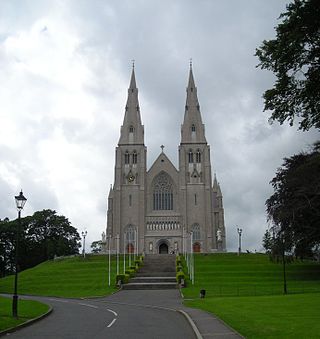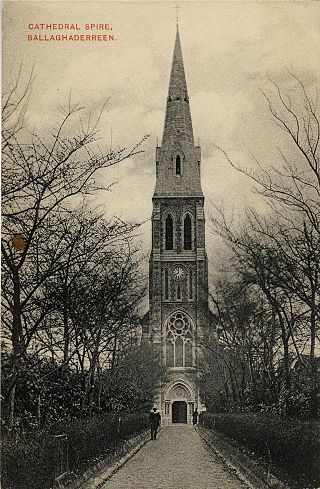| Styles of James Dowley | |
|---|---|
 | |
| Reference style | The Most Reverend |
| Spoken style | My Lord |
| Religious style | Bishop |
James Dowley (also known as Dooley) (died 1684) was an Irish Roman Catholic prelate who served as the Bishop of Limerick from 1720 to 1737.
| Styles of James Dowley | |
|---|---|
 | |
| Reference style | The Most Reverend |
| Spoken style | My Lord |
| Religious style | Bishop |
James Dowley (also known as Dooley) (died 1684) was an Irish Roman Catholic prelate who served as the Bishop of Limerick from 1720 to 1737.
James Dowley studied in Paris during the 1630s. After his return to Limerick as priest he was appointed chancellor and vicar-general by bishop O'Dwyer. After the 1651 Siege of Limerick he escaped to Spain. He remained in the service of Baltasar Cardinal Moscoso y Sandoval. In Toledo he came to know the Kerry Dominican and distinguished historian Dominic O'Daly OP. he gave a first hand account of the siege to O'Daly. Dowley moved to Rome in 1655 where he unsuccessfully sought the office of Vicar Apostolic of Limerick. Instead he became rector of the College of the Neophytes. Amongst the distinguished Irish ecclesiastics present in Rome at this time were Oliver Plunkett and John Brennan. [1]
On 19 1669 Dowley was appointed Vicar Apostolic of Limerick. Despite initial hesitation about the appointment which was expressed to William Burgat the clergy of the diocese accepted Dowley. After his arrival in the diocese he endeavoured to visit every church and sent a report to Rome. The diocese was judged to be in good shape despite not having a bishop for fifteen years. Douley was consecrated bishop on 19 August 1677 with the principal consecrator being his old Roman friend John Brenan who assisted by Bishop Creagh of Cork and James Phelan of Ossory. [2] Dowley's episcopate was dominated by the so-called Popish Plot a period of anti-Catholic hysteria that made any activity as a bishop dangerous. In 1678 he was released by the authorities under surety due to his ill health but he continued to act as bishop throughout. he died in 1684. [3] [4]

The Dominican Order has been present in Ireland since 1224 when the first foundation was established in Dublin, a monastic settlement north of the River Liffey, where the Four Courts is located today. This was quickly followed by Drogheda, Kilkenny (1225), Waterford (1226), Limerick (1227) and Cork (city) (1229). The order was reestablished in the 19th century after having been driven out in the 17th century by laws against Catholic religious orders. During the Penal Laws, as other Irish Colleges were established on the continent, in 1633 the Irish Dominicans established, the College of Corpo Santo, Lisbon and College of the Holy Cross, Louvain (1624-1797) to train clergy for ministering in Ireland. San Clemente al Laterano in Rome, was entrusted to the Irish Dominicans in 1677. In 1855, St. Mary's Priory, Tallaght, was established to train members of the order, who would complete their clerical studies in Rome and be ordained in the Basilica San Clemente.

The Archdiocese of Armagh is an ecclesiastical territory or archdiocese of the Catholic Church located in the northern part of Ireland. The ordinary is the Roman Catholic Archbishop of Armagh who is also the Metropolitan of the Ecclesiastical province of Armagh and the Primate of All Ireland. The mother church is St Patrick's Cathedral. The claim of the archdiocese to pre-eminence in Ireland as the primatial see rests upon its traditional establishment by Saint Patrick circa 445. It was recognised as a metropolitan province in 1152 by the Synod of Kells.

John Briggs was an English prelate of the Roman Catholic Church. He served as the first Bishop of Beverley from 1850 to 1860.

The Roman Catholic Diocese of Achonry is a Roman Catholic diocese in the western part of Ireland. It is one of the five suffragan sees of the Archdiocese of Tuam. The diocese was often called the "bishopric of Luighne" in the Irish annals. It was not established at the Synod of Rathbreasail, but Máel Ruanaid Ua Ruadáin signed as "bishop of Luighne" at the Synod of Kells.

Dermot Clifford,, was the Catholic Archbishop of Cashel and Emly in Ireland from 1988 to 2014. From 7 March 2009 to 27 January 2013, he also served as the Apostolic Administrator of the Diocese of Cloyne. He was a founding board member of Bothar.
The Roman Catholic Diocese of Port Elizabeth is a diocese located in the city of Port Elizabeth in the Ecclesiastical province of Cape Town in South Africa.

The Bishop of Limerick is an episcopal title which takes its name after the city of Limerick in the Province of Munster, Ireland. In the Roman Catholic Church it still continues as a separate title, but in the Church of Ireland it has been united with other bishoprics.
The Bishop of Emly was a separate episcopal title which took its name after the village of Emly in County Tipperary, Republic of Ireland. In both the Church of Ireland and the Roman Catholic Church, it has been united with other sees.
This article summarizes allegations and investigations of child sexual abuse by clergymen in the Roman Catholic Diocese of Limerick, Ireland.
John Gray (1817–1872) was a Roman Catholic bishop who served as the Vicar Apostolic of the Western District of Scotland.
Brendan Leahy is an Irish Roman Catholic prelate and theologian who has served as Bishop of Limerick since 2013.

James Quinn, also known as James O'Quinn, was an Irish-Australian prelate of the Catholic Church and the first bishop of the Diocese of Brisbane.
John Butler, S.J. was an Irish Roman Catholic priest who was appointed as Bishop of Limerick in 1778 and resigned the position in 1779 without ever being consecrated.
Thomas Arthur was a Roman Catholic prelate who served as Bishop of Limerick (1469–1486).
Gillebert ; c. 1070–1145) was an Irish Roman Catholic prelate who served as the Bishop of Limerick from 1106 to 1140.
Gerald Le Marescal was Bishop of Limerick in the late 13th and early 14th centuries.

John Baptist Sleyne was Roman Catholic Bishop of Cork and Cloyne and Apostolic Administrator of the diocese of Ross, who was an enthusiastic patron of the Gaelic language and culture, and an advocate of the severely repressed Roman Catholic population, in Ireland during the early period of the Penal Laws. He was one of only two bishops to minister in Ireland at the end of the 17th century. Sleyne was very learned in languages and moral theology, and had traveled widely. He was known to and had interactions with kings, queens, popes and wider cultural and religious establishment throughout Ireland and Europe. Because Sleyne "remain[ed] in the kingdom contrary to the [penal] law", of the time, he went into hiding. He was eventually brought before the courts in 1698 and spent five years in prison in Cork Gaol. During his time as Bishop, both as fugitive and prisoner, Sleyne ordained many priests and consecrated several bishops in Ireland. He was eventually exiled to Portugal, on 11 February 1703, where he was given shelter in the Irish Dominican Convento do Bom Sucesso, Lisbon. He died in Portugal on 16 February 1712, aged 74 years and is buried at the altar of the Sacred Heart in the Church of Nossa Senhora do Bom Sucesso.
Richard Arthurc. 1560–4 May 1646) was an Irish Roman Catholic prelate who was Bishop of Limerick from 1623 to 1646.
John Folan was the Roman Catholic Bishop of Limerick from 1489 until his death.
Thomas Leger was a Roman Catholic prelate who briefly served as Bishop of Limerick.